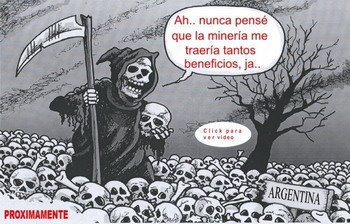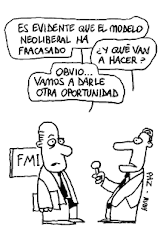Sobre las declaraciones del Ministro de CyT Lino Barañao sobre el trabajo del Dr. Andrés Carrasco y
sobre clasificaciones de FAO, WHO y EPA sobre el pesticida en cuestión, el glifosato.
Dirigido a:
Mi nombre es Lilian Joensen, soy bióloga, Dra. de
Por la presente quisiera hacer llegar las referencias sobre las cuales
He tratado de buscar las referencias que utiliza
Es importante tener en cuenta que las clasificaciones de
Lino Barañao critica al Dr. Andrés Carrasco porque no esperó a publicar sus resultados, para que ellos fueran revisados por referís pares utilizados por las revistas científicas, normalmente. Lo que no veo, es que se critique a los organismos de
A continuación, copio las referencias utilizadas en algunos ejemplos de documentos publicados en
1) (http://www.who.int/water_sanitation_health/dwq/chemicals/glyphosateampa290605.pdf
Las referencias para esta revisión y recomendación de este documento sobre agua potable de
Bio/Dynamics Inc. (1981b) A three-generation reproduction study in rats with glyphosate. Final
report. Unpublished report prepared by Bio/Dynamics Inc., Division of Biology and Safety Evaluation,
East Millstone, NJ. Submitted to WHO by Monsanto Ltd. (Project No. 77-2063; BDN-77-147).
Bio/Dynamics Inc. (1983) A chronic feeding study of glyphosate (Roundup technical) in mice.
Unpublished report prepared by Bio/Dynamics Inc., Division of Biology and Safety Evaluation, East
Millstone, NJ. Submitted to WHO by Monsanto Ltd. (Project No. 77-2061; BDN-77-420).
CCME (1989) Canadian water quality guidelines.
Council of Ministers of the Environment.
FAO/WHO (1986) Pesticide residues in food — 1986. Evaluations — 1986. Part I — Residues.
Food and Agriculture Organization of the United Nations, Joint FAO/WHO Meeting on Pesticide
Residues (FAO Plant Production and Protection Paper 78).
FAO/WHO (1987) Pesticide residues in food — 1986. Evaluations — 1986. Part II — Toxicology.
Production and Protection Paper 78/2).
FAO/WHO (1998) Pesticide residues in food — 1997 evaluations. Part II — Toxicological and
environmental.
(WHO/PCS/98.6).
IPCS (1994) Glyphosate.
Safety (Environmental Health Criteria 159). El IPCS tampoco hace los estudios, sino que hace una revisión donde se basan en estudios hechos por la industria principalmente y entregados por Monsanto mismo.
IRDC (1980a) Test article — Technical glyphosate: Teratology study in rats. Unpublished report
prepared by International Research and Development Corporation, Mattawan, MI. Submitted to WHO
by Monsanto Ltd. (Study No. 401-054; Reference No. IR-79-016).
IRDC (1980b) Test article — Technical glyphosate: Teratology study in rabbits. Unpublished report
prepared by International Research and Development Corporation, Mattawan, MI. Submitted to WHO
by Monsanto Ltd. (Study No. 401-056; Reference No. IR-79-018).
Kjaer J et al. (2004) The Danish pesticide leaching assessment programme: monitoring results 1999–
2003.
(http://pesticidvarsling.dk/monitor_uk/2003.html).
Monsanto (1987) 90 day study of glyphosate administered in feed to Sprague-Dawley rats.
Unpublished report No. MSL 7575, prepared and submitted to WHO by Monsanto Ltd., Monsanto
Environmental Health Laboratory,
Monsanto (1990a) Chronic study of glyphosate administered in feed to albino rats. Unpublished report
prepared and submitted to WHO by Monsanto Ltd., Monsanto Environmental Health Laboratory,
Louis
Monsanto (1990b) Two generation reproduction feeding study with glyphosate in Sprague-Dawley
rats. Unpublished report prepared and submitted to WHO by Monsanto Ltd., Monsanto Environmental
Health Laboratory,
NTP (1992) NTP technical report on toxicity studies of glyphosate (CAS No. 1071-83-6).
Triangle Park
WHO (1996) The WHO recommended classification of pesticides by hazard and guidelines to
classification 1996–1997.
Safety (WHO/PCS/96.3).
2) En este documento de
3) Esta evaluación de
Allin, J.C. 1989. Glyphosate residues in wheat grain and straw after pre-harvest treatment. Report No. MSL-8959. Unpublished.
Cowell, J.E 1977. Glyphosate residue in soya bean following post-directed treatments of glyphosate. Agricultural
Research Report No. 469. Monsanto. Unpublished.
Cowell, J.E., Kunstman, J.L, Nord, P.J., Steinmetz, J.R. and
residue method for analysis of glyphosate and metabolite: an interlaboratory study. J. Ag. Fd Chem. 34, 955-980.
Kunstman, J.L. 1983. Glyphosate residues in soya beans and soya bean fractions following recirculating sprayer
and pre-harvest topical treatments. Report No. MSL-3259. Monsanto. Unpublished.
Kunstman, J.L 1984. Glyphosate residues in soya beans and forage in crops from
equipments treatments with glyphosate herbicide. Report No. MSL-3353. Monsanto. Unpublished.
Kunstman, J.L. 1989. Glyphosate residues in soya bean grain and fodder following topical or directed application.
Report No MSL-7894. Monsanto. Unpublished.
Mueth, M.G. 1988. Glyphosate residues in Canadian soya beans after pre-harvest treatment. Report No. MSL-
8120. Monsanto. Unpublished.
glyphosate, 1993 trials. Report No. MSL-13283. Monsanto. Unpublished.
Steinmetz, J.R 1985. Glyphosate residues in soya beans and dry beans from
treatments with Glyphosate. Report No. MSL-5068. Monsanto. Unpublished.
Steinmetz, J.R. 1987. Reanalysis of glyphosate residues in soya beans and cotton following spot treatment of
glyphosate at late stages of plant growth. Report No. MSL-5642. Unpublished.
Steinmetz, J.R. and Cowell, J.E. 1984. Glyphosate residues in wheat grain milling/fractionation products. Report
No. MSL-4005. Monsanto. Unpublished.
4) Lo mismo sucede cuando se miran las referencias de
Solo como ejemplos:
I.A.2. Principal and Supporting Studies (Oral RfD) Monsanto Company. 1981a. MRID No. 0081674, 00105995. Available from EPA. Write to FOI, EPA,
...Additional Studies/Comments (Oral RfD)...Reproduction - rat: Principal study - see previous description; core grade minimum 2) 2-Year Feeding (oncogenicity) - rat: Dietary levels tested: 0, 30, 100, and 300 ppm (Male...(Monsanto Co., 1981b), etc.
5) El Informe de 2004 del JMPR del Encuentro de Experto de FAO/OMS (Report of the 2004 JMPR FAO/WHO Meeting of Experts, http://www.fao.org/ag/AGP/AGPP/Pesticid/JMPR/DOWNLOAD/2004_rep/report2004jmpr.pdf), se vuelve a basar en los mismos propios informes anteriores sobre las mismas referencias. Este informe es uno sobre los cuales se basa el comunicado de prensa de CASAFE Acerca de
6) Nada nuevo se muestra en el Inventario de del IPCS y otras evaluaciones de pesticidas de
resumen de las evaluaciones toxicológicas llevadas a cabo por el Encuentro Conjunto sobre Residuos de
Pesticidas (JMPR) Es decir, estos estudios siguen siendo basados en revisiones no revisadas de estudios,
mayormente provistos por Monsanto. (http://www.who.int/ipcs/publications/jmpr/pesticide_inventory.pdf)
Creo que cabe agregar, que a partir del uso del glifosato en soja resistente al Round up, se viene observando la aparición y diseminación de malezas también tolerantes o resistentes al mismo herbicida. Por ello, y esto esta documentado incluso por los órganos lobbistas de la siembra directa, se ha aumentado también la utilización de otros pesticidas que suman a toda una batería de productos tóxicos, para el ser humano y el medio del cual somos parte. El barbecho químico forma parte del sistema de siembra directa que ha fomentado la producción de soja resistente al Round up.
Saludo con toda atención
Lilian Joensen,
Grupo de Reflexión Rural


























No hay comentarios:
Publicar un comentario